Nokia Lumia 800 Review - Nokia's Brave New Foray into WP7
by Brian Klug on January 4, 2012 7:00 AM EST- Posted in
- Smartphones
- Nokia
- windows phone 7
- Mobile
- WP7
- Lumia
- Lumia 800
I think it’s important to start out with battery life for two reasons - I end up spending a huge majority of my time doing battery life tests, and in the case of the Lumia 800 much has been written about battery-related issues. The full disclosure is that the Lumia 800 unfortunately does have some rather glaring power and charging related problems. The first Lumia 800 we were sampled suffered from a battery-related problem that caused spontaneous rebooting during use and some charging issues. This was swapped out for another that had the updated release version firmware on it. This second device is the one I spent my majority of time with, although this second device also periodically reboots, though not as much.
The second issue is one that becomes visible when you fully discharge the phone, which naturally we do a lot of while testing battery. If you discharge the phone completely, and then attempt to re-charge, occasionally the phone will go into an endless boot loop, where it powers on, starts WP7, detects that the battery is below its power-off threshold, and shut down. Then the cycle repeats. Ordinarily this isn’t a big deal, but for some reason the PMIC (Qualcomm's PM8058) doesn’t really charge the phone while this is going on. I encountered this once, and even after 3 days of charging couldn’t boot successfully until I did a hard reset with the Nokia triple finger salute. The other minor issue is that if you get the phone into this low power state, sometimes it won’t pull any current to charge the phone. It takes a few attempts and getting the phone into the right pre-boot environment for this to work properly.
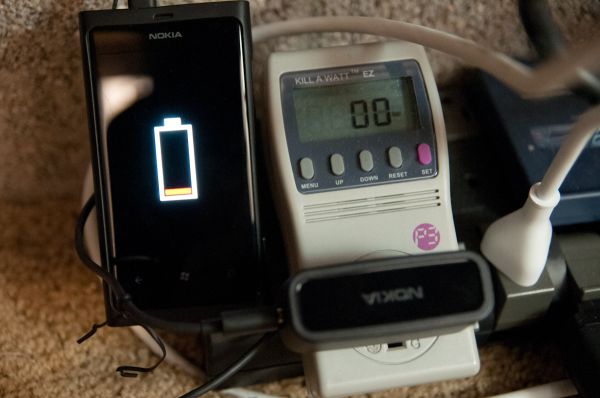 Plugged in but not drawing any current - Unplugging and replugging eventually gets the Lumia 800 to charge correctly and draw 5-6W.
Plugged in but not drawing any current - Unplugging and replugging eventually gets the Lumia 800 to charge correctly and draw 5-6W.
The latest update for the Lumia 800 as of this writing is 1600.2479.7740.11451 and includes “charging improvements” in its change-log, so it’s possible this issue has been addressed already, though there’s another update coming down the line as well. The Lumia 800 we were sampled only was being pushed “1600.2475.7720.11414” due to Microsoft’s staggered update push progress, so again it’s possible this is totally fixed.
There’s a debug menu which can be launched with the dialer code ##634#, and afterwards appears in the normal application list as well. In here you can see the real battery status, charge capacity, and even the instantaneous current draw no doubt as reported by the PMIC. While I wasn’t affected with the bug that sends the charge capacities to 0 mAh, this is still a useful menu.
So the normal corners of our battery life testing are how long the phone lasts while loading pages over 3G and WiFi, and then call time. Page load tests take place with the display set at 200 nits, though on WP7 the only display options are Low, Medium, and High (we selected Medium). We’ve added hotspot tests too which eliminate the display from being a factor, though these aren’t presently able to be tested on WP7.
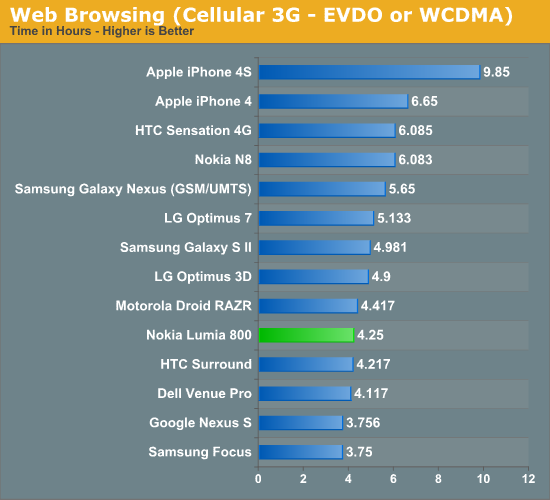
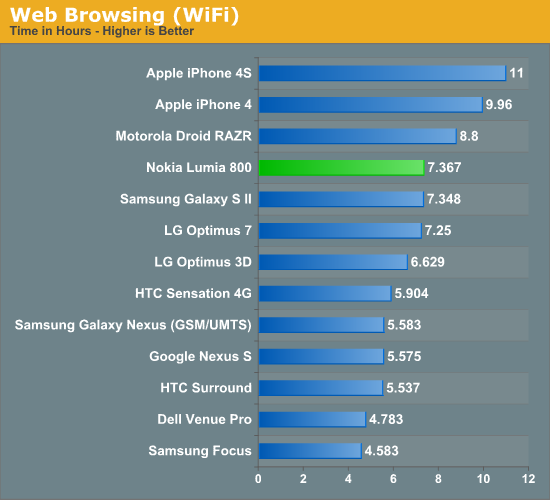
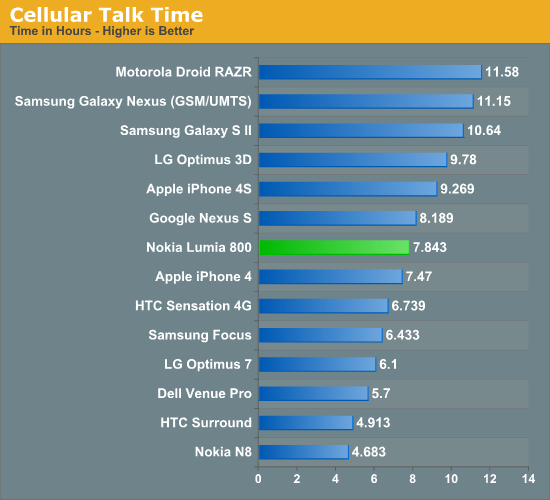
The Lumia leads the pack of WP7 devices we’ve tested in two out of the three categories, but lags the LG Optimus 7 when it comes to loading pages on cellular data. I’m decently impressed with how well the Lumia does considering its 1450mAh (5.37 Whr) battery, yet it could be better. Having an AMOLED display in conjunction with our primarily white background webpages from the page loading suite definitely makes an impact. I can’t help but wonder whether these numbers will improve or not after Nokia also updates firmware and fixes some of the battery life bugs have been publicly acknowledged.
I noticed some other subtle behavior while testing the Lumia 800. A new feature in WP7.5 “mango” is the addition of a battery saver tab under settings which optionally allows automatic pausing of background data and dimming of the display when battery gets low. In this menu you can also view battery percentage and some estimates of battery life remaining based on historical use. With the second updated Lumia 800, the phone turns off at 5%, presumably to mitigate the reboot loop that sometimes results if the phone is discharged to 0%. So there’s at least an extra 5% of battery life hanging around that no doubt will be exposed with the eventual update.


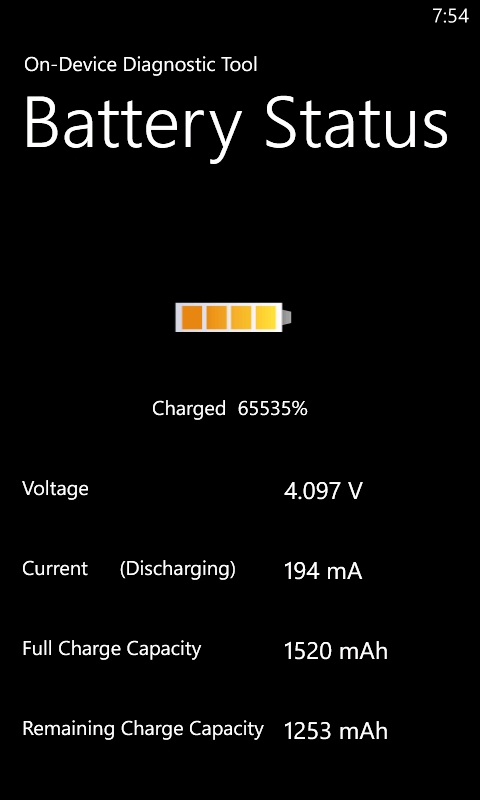
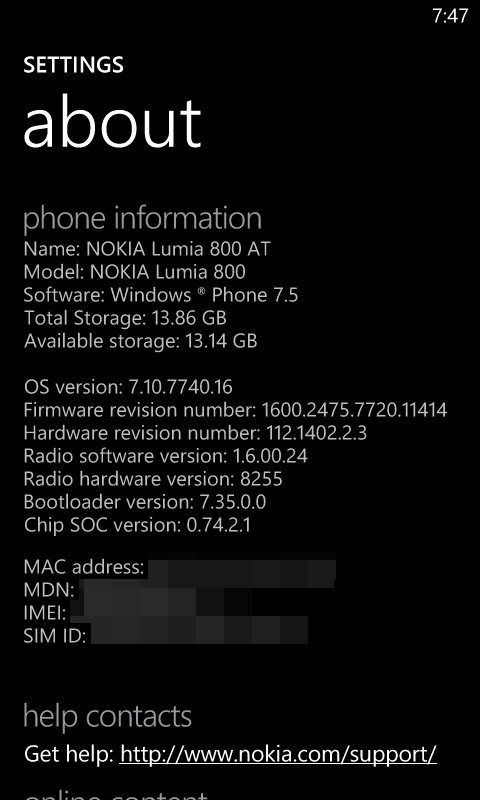
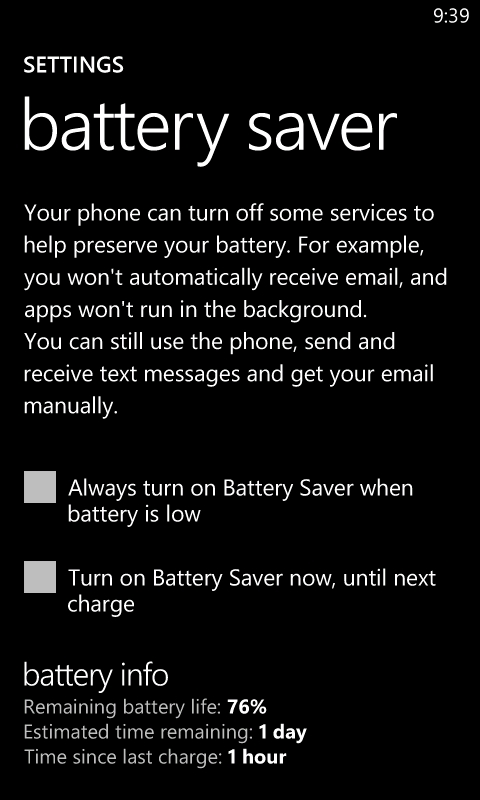








120 Comments
View All Comments
Iketh - Wednesday, January 4, 2012 - link
You can't watch youtube videos without the app on WP. If you try, the website instructs you to download the youtube app first. You can browse youtube all you want, just can't play the videos. The way the site words this almost makes it sound like it's youtube's fault, but I wouldn't know.melgross - Wednesday, January 4, 2012 - link
So, this is a fairly mediocre phone as far as performance goes, but the reviewer really wants to believe it to be better than it is.It's pretty obvious that WP7+ needs a dual core SoC, with a much better GPU. When that happens, we'll see a phone that can properly compare to the other top phones on other OS's, such as Android and iOS. Until then, no excuses can fix the slow nature of this model. If this were a cheaper, lower end model, it might be worthwhile, but for the flagship model, it's simply not worth it.
And then, AMOLED isn't really ready for prime time. Despite the propaganda from the manufacturers who use them, I've not yet seen a review of an AMOLED device that was more than about half as bright as a good LCD model, and often no better than a third as bright. This one seems poor. To say that it seems brighter than it can possibly be, is nonsense.
I hope that we will see much better phones than this one during the year, and soon. If not, it will be another reason why WP7 will struggle.
Brian Klug - Wednesday, January 4, 2012 - link
I'd agree with that assertion - WP7 does need to make the move to dual core, (and will make the move to dual core) if nothing else to get all the other features that come with it. I touched on this a little, but better encoders, better decoders, and on the QCT side better baseband all come on the high-end before eventually showing up on the midrange.The other curious thing is that AMOLED can actually go way brighter (with some of Supercurio's hacks, you can drive the SGS2 SAMOLED Plus display up past 500 nits) but you end up just burning through battery. Obviously there's still some balancing being done by OEMs to keep battery from being totally depleted.
-Brian
melgross - Wednesday, January 4, 2012 - link
There are several very good reasons why AMOLEDs aren't bright. LED's of all kinds, but especially OLED'S, are very constrained by temperature. The higher they are driven, the hotter they get. The hotter they get, the shorter the life. Driving an AMOLED screen to the brightness of the 4S, for example, would bring the lifetime down to less than a quarter of what it is now.In addition, this isn't a linear relationship. More voltage results in less than a 1:1 relationship in brightness, and an even worse relationship when looking at current draw. There's a good reason why UI's designed for AMOLED's use a great deal of black with thin lettering. On average, right now, even the best AMOLEDs use more current than do most LCDs with high efficiency LED backlighting. I find it amusing when I read that AMOLEDs use less energy, when they use more.
I have a lot of LED's here, up to 200 watts (for a single LED). I've yet to find one that lives up to its promise, though they're getting better. I would give AMOLED's at least another two years, and with IGZO displays coming out, possibly another four years until they equal the efficiency.
Color quality, which is poor, is another question altogether.
french toast - Thursday, January 5, 2012 - link
AMOLEDs typically dont come half as bright as the brightest lcds, hell the nokia 701 gets over 1000nits brightness!! so thats 5 times brighter than this model.However brightness tests like this rarely carry through to real life,especially when talking about AMOLEDS, they have the best contrast ratio as well as saturated colours which make the screen pop, you never read a review about an AMOLED phone and get complaints about it being dull..quite the contrary the AMOLED always seems to be brighter..
If brian hadnt ran that test, he wouldnt have mentioned that the screen seems dull.
Some of the appeal of AMOLEDS is that over saturated colour profile, which seems to be a marmite issue, half the people prefer IPS LCD and half swear by a decent RGB AMOLED.
AMOLEDS have many advantages over LCD though, they are thinner, much much better contrast, far far superior response time, more eye popping colours and better power levels when watching dark seens like movies...The sunlight issue which was the worse complaint has disapeared.
One of the biggest complaints about AMOLED compared to a high quality LCD is color accuracy..BUT although this is a bug for some,
most people PREFER the saturated colors, indeed when i read reviews on you tube of people comparing the most accurate hd phone display yet..the IH-IPS display on the LG Nitro the reviewers said they much prefered the nexus display, and that somehow it gave the impression of being BRIGHTER..despite what these tests say.
Spivonious - Wednesday, January 4, 2012 - link
Slow nature of this model? I have one of the launch WP7 phones (LG Quantum), and experience no slowness. The fact is that MS has optimized the OS to perform on a single-core CPU. The phone OEMs are free to add an improved GPU, but there's no need for it. Javascript benchmarks are meaningless to me. Who browses the web for any amount of time on a 4" screen?melgross - Wednesday, January 4, 2012 - link
Just read the tests. It's all there. Sometimes something doesn't feel as slow, or as fast as it is, but the numbers don't lie.465thGTG - Wednesday, January 4, 2012 - link
I'll take real world feel over benchmark numbers any day. My Titan feels faster and more fluid than my Galaxy S II. What else is there to say?doubledeej - Thursday, January 5, 2012 - link
If someone spent all day every day running Javascript, I might agree with you. But so little of the time spent using the phone is spent doing that. Everything else about the phone feels much faster than ANY Android model, regardless of CPU speed or number of cores. Having everything be GPU accelerated makes a world of difference in how fast it feels.You just never wait for anything other than your data connection on these phones.
doobydoo - Saturday, January 7, 2012 - link
I've never tried the Titan, but your reasoning is exactly why the iPhone 4S feels faster than the Galaxy S2 too - the GPU hardware acceleration.That and the fact it has the fastest CPU/GPU combination of any phone ever made.